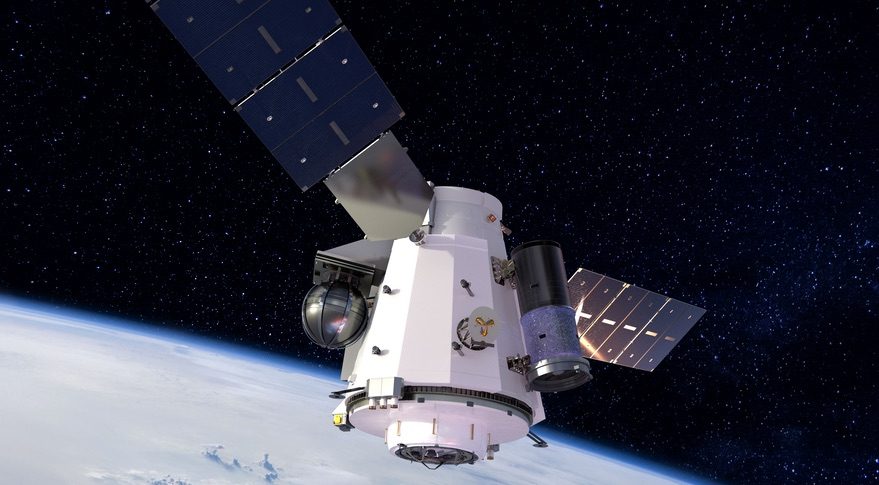Three companies studying “Orbital Outpost” space station concepts for Defense Department
Three companies studying “Orbital Outpost” space station concepts for Defense Department

WASHINGTON — Three companies have received study contracts from a Defense Department agency regarding concepts for small, uncrewed space stations in low Earth orbit, although none of the awards yet fund spacecraft construction.
Sierra Nevada Corporation (SNC) announced July 14 that it won a contract from the Defense Innovation Unit (DIU) for that agency’s “Unmanned Orbital Outpost,” which the company described in its release as “essentially a scalable, autonomous space station for experiments and logistics demonstrations.”
SNC said that, for this award, it would repurpose the “Shooting Star” cargo module that it developed for its Dream Chaser spacecraft. Shooting Star provides additional cargo capacity for missions to the International Space Station, and will be used for the disposal of cargo after departing the station while the Dream Chaser spaceplane glides back to Earth.
“The current Shooting Star is already designed with significant capabilities for an orbital outpost and by adding only a few components we are able to meet Department of Defense needs,” Steve Lindsey, senior vice president of strategy for SNC’s Space Systems business area, in a company statement. “We are proud to offer our transport vehicle to DoD as a free-flying destination for experimentation and testing, expanding beyond its current payload service capabilities for Dream Chaser cargo missions.”
Company executives said in January they were looking to expand the use of Shooting Star beyond Dream Chaser cargo missions, including standalone low Earth orbit missions as well as transport of cargo to NASA’s lunar Gateway. “Basically, what it is is a large, low-cost satellite that has both pressurized and unpressurized capabilities for multiple customers,” Lindsey said then of Shooting Star.
Using Shooting Star as a standalone satellite will require a few modifications. Company spokesperson Kimberly Schwandt said July 15 those changes include the addition of a “handful of sensors and systems” to the spacecraft that are located on the Dream Chaser vehicle on ISS missions.
The SNC announcement, though, did not include a dollar value for the award or a schedule. Schwandt said the award covers a system requirements review that “includes design, development and test of the Outpost based on the Shooting Star and Dream Chaser spacecraft technologies.” The company declined to disclose financial details of the award.
DIU, though, confirmed to SpaceNews that the award was a study contact, one of three the agency issued for the Orbital Outpost program. “These vary by company since some solutions are more evolved than others,” Brig. Gen. Steve Butow, director of DIU’s Space Portfolio, said. “Solutions must be capable of being established in low Earth orbit within 24 months of contract award following the study.”
DIU declined to give the value of the awards or name the other companies, saying the agency leaves it up to the companies to provide that information. However, a search of procurement information posted on beta.SAM.gov shows that DIU awarded SNC $439,100 for “Phase 1: Orbital Outpost Prototype Project” in February.
The same database also shows that DIU issued a second award to Nanoracks for $389,900 in late 2019 for the same project. Jeffrey Manber, chief executive of Nanoracks, confirmed the company is working with DIU on the project as part of a broader company effort to study converting upper stages and other structures into operational spacecraft, such as space station modules.
“Nanoracks is currently performing a study for DIU, looking at cost-efficient means for repurposing in-space hardware,” he said July 17. “We are really pleased at the progress and share with DIU a vision of a more vibrant in-space ecosystem, where we make better use of the hardware in space rather than throwing away perfectly good space hardware post-primary mission.”
A third company, Arkisys, received $366,000 from DIU for the Orbital Outpost project in March. The company, based in Southern California, says on its website that it will build “platforms and vessels that will be able to be re-docked and re-used again and again” to enable low-cost space applications, but provided few other details. A message sent to an email address on the website bounced back as undeliverable.
When DIU issued a call for proposals in July 2019 for the Orbital Outpost project, it said it was seeking concepts for a “self-contained and free flying” spacecraft “capable of supporting space assembly, microgravity experimentation, logistics and storage, manufacturing, training, test and evaluation, hosting payloads, and other functions.” Its minimum requirements included one cubic meter of internal volume, 80 kilograms of payload capacity and one kilowatt of power.
DIU also provided a list of “desired future capabilities” for the outpost. Those ranged from supporting in-space servicing for extending the spacecraft’s lifetime to the ability to change orbits and even human rating.
“The most immediate and logical use is to facilitate the flight qualification of new hardware,” Butow said of the Orbital Outpost concept. “The use of a persistent on-orbit platform is a more effective means of hosting these payloads and advancing the Technology Readiness Level (TRL) of these items.”
Those payloads, he said, could include those on the Defense Department’s Space Experiments Review Board list, which prioritizes research and development payloads seeking a flight to space.
“Additionally, all outposts will provide services to their payloads including power, communications and possibly robotics,” he said. “Besides prototype payloads, outposts are intended to serve as logistics nodes and as such could host fuel depots and support berthing or docking.”
Comments
Post a Comment